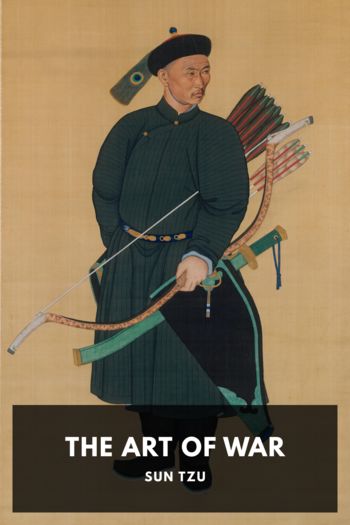The Art of War by Sun Tzu (elon musk reading list TXT) 📕

- Author: Sun Tzu
Book online «The Art of War by Sun Tzu (elon musk reading list TXT) 📕». Author Sun Tzu
The copy which I have used belongs to a reissue dated 1877. It is in 6 pên, forming part of a well-printed set of 23 early philosophical works in 83 pên.91 It opens with a preface by Sun Hsing-yen (largely quoted in this introduction), vindicating the traditional view of Sun Tzǔ’s life and performances, and summing up in remarkably concise fashion the evidence in its favor. This is followed by Tsʽao Kung’s preface to his edition, and the biography of Sun Tzǔ from the Shih Chi, both translated above. Then come, firstly, Chêng Yu-hsien’s I Shuo,92 with author’s preface, and next, a short miscellany of historical and bibliographical information entitled 孫子敘錄 Sun Tzǔ Hsü Lu, compiled by 畢以珣 Pi I-hsün. As regards the body of the work, each separate sentence is followed by a note on the text, if required, and then by the various commentaries appertaining to it, arranged in chronological order. These we shall now proceed to discuss briefly, one by one.
The CommentatorsSun Tzǔ can boast an exceptionally long distinguished roll of commentators, which would do honor to any classic. 歐陽修 Ou-yang Hsiu remarks on this fact, though he wrote before the tale was complete, and rather ingeniously explains it by saying that the artifices of war, being inexhaustible, must therefore be susceptible of treatment in a great variety of ways.93
曹操 Tsʽao Tsʽao or 曹公 Tsʽao Kung, afterwards known as 魏武帝 Wei Wu Ti (AD 155–220). There is hardly any room for doubt that the earliest commentary on Sun Tzǔ actually came from the pen of this extraordinary man, whose biography in the San Kuo Chih94 reads like a romance. One of the greatest military geniuses that the world has seen, and Napoleonic in the scale of his operations, he was especially famed for the marvelous rapidity of his marches, which has found expression in the line 說曹操曹操就到 “Talk of Tsʽao Tsʽao, and Tsʽao Tsʽao will appear.” Ou-yang Hsiu says of him that he was a great captain who “measured his strength against Tung Cho, Lü Pu and the two Yüan, father and son, and vanquished them all; whereupon he divided the Empire of Han with Wu and Shu, and made himself king. It is recorded that whenever a council of war was held by Wei on the eve of a far-reaching campaign, he had all his calculations ready; those generals who made use of them did not lose one battle in ten; those who ran counter to them in any particular saw their armies incontinently beaten and put to flight.”95 Tsʽao Kung’s notes on Sun Tzǔ, models of austere brevity, are so thoroughly characteristic of the stern commander known to history, that it is hard indeed to conceive of them as the work of a mere littérateur. Sometimes, indeed, owing to extreme compression, they are scarcely intelligible and stand no less in need of a commentary than the text itself.96 As we have seen, Tsʽao Kung is the reputed author of the 新書, a book of war in 100,000 odd words, now lost, but mentioned in the 魏志.97
孟氏 Mêng Shih. The commentary which has come down to us under this name is comparatively meager, and nothing about the author is known. Even his personal name has not been recorded. Chi Tʽien-pao’s edition places him after Chia Lin, and 鼂公武 Chʽao Kung-wu also assigns him to the Tʽang dynasty,98 but this is a mistake, as his work is mentioned in the 隋書經籍志. In Sun Hsing-yen’s preface, he appears as Mêng Shih of the Liang dynasty (502–557). Others would identify him with 孟康 Mêng Kʽang of the 3rd century. In the 宋史藝文志,99 he is named in one work as the last of the 五家 “Five Commentators,” the others being Wei Wu Ti, Tu Mu, Chʽên Hao and Chia Lin.
李筌 Li Chʽüan of the 8th century was a well-known writer on military tactics. His 太白陰經 has been in constant use down to the present day. The 通志 mentions 閫外春秋 (lives of famous generals from the Chou to the Tʽang dynasty) as written by him.100 He is also generally supposed to be the real author of the popular Taoist tract, the 陰符經. According to Chʽao Kung-wu and the Tʽien-i-ko catalogue,101 he followed





Comments (0)